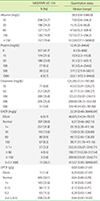1. Ginsberg JM, Chang BS, Matarese RA, Garella S. Use of single voided urine samples to estimate quantitative proteinuria. N Engl J Med. 1983; 309:1543–1546.


2. Rodby RA, Rohde RD, Sharon Z, Pohl MA, Bain RP, Lewis EJ. The urine protein to creatinine ratio as a predictor of 24-hour urine protein excretion in type 1 diabetic patients with nephropathy. The Collaborative Study Group. Am J Kidney Dis. 1995; 26:904–909.


3. Hutchison AS, O'Reilly DS, MacCuish AC. Albumin excretion rate, albumin concentration, and albumin/creatinine ratio compared for screening diabetics for slight albuminuria. Clin Chem. 1988; 34:2019–2021.


4. Bartz SK, Caldas MC, Tomsa A, Krishnamurthy R, Bacha F. Urine albumin-to-creatinine ratio: a marker of early endothelial dysfunction in youth. J Clin Endocrinol Metab. 2015; 100:3393–3399.


6. Clase CM, Gao P, Tobe SW, McQueen MJ, Grosshennig A, Teo KK, et al. Estimated glomerular filtration rate and albuminuria as predictors of outcomes in patients with high cardiovascular risk: a cohort study. Ann Intern Med. 2011; 154:310–318.


7. Cho H. Prevalence of microalbuminuria and its associated cardiometabolic risk factors in Korean youth: data from the Korea National Health and Nutrition Examination Survey. PLoS One. 2017; 12:e0178716.

8. American Diabetes Association. Standards of medical care in diabetes-2015 abridged for primary care providers. Clin Diabetes. 2015; 33:97–111.


9. Carville S, Wonderling D, Stevens P. Guideline Development Group. Early identification and management of chronic kidney disease in adults: summary of updated NICE guidance. BMJ. 2014; 349:g4507.

10. Kim JH, Oh SY, Kim EH, Lee MJ, Jeon YK, Kim BH, et al. Addition of nonalbumin proteinuria to albuminuria improves prediction of type 2 diabetic nephropathy progression. Diabetol Metab Syndr. 2017; 9:68.

11. Salmon L, Mastrolia SA, Hamou B, Wilkof-Segev R, Beer-Weisel R, Klaitman V, et al. Urine protein-to-creatinine ratio: a point of care for the diagnosis of preeclampsia. Minerva Ginecol. 2018; 70:246–253.


12. Kucukgoz Gulec U, Sucu M, Ozgunen FT, Buyukkurt S, Guzel AB, Paydas S. Spot urine protein-to-creatinine ratio to predict the magnitude of 24-hour total proteinuria in preeclampsia of varying severity. J Obstet Gynaecol Can. 2017; 39:854–860.


14. Benedict SR. Some applications of a new color reaction for creatinine. J Biol Chem. 1936; 114:515–532.

15. Parsons M, Newman DJ, Pugia M, Newall RG, Price CP. Performance of a reagent strip device for quantitation of the urine albumin: creatinine ratio in a point of care setting. Clin Nephrol. 1999; 51:220–227.

16. Konta T, Hao Z, Takasaki S, Abiko H, Ishikawa M, Takahashi T, et al. Clinical utility of trace proteinuria for microalbuminuria screening in the general population. Clin Exp Nephrol. 2007; 11:51–55.


17. McTaggart MP, Price CP, Pinnock RG, Stevens PE, Newall RG, Lamb EJ. The diagnostic accuracy of a urine albumin-creatinine ratio point-of-care test for detection of albuminuria in primary care. Am J Kidney Dis. 2012; 60:787–794.


18. Lim S, Yu HJ, Lee S, Park H, Kwon MJ, Woo HY. Evaluation of the URi-SCAN 2 ACR Strip to estimate the urine albumin/creatinine ratios. J Clin Lab Anal. 2017; 32:1–6.

19. Nah EH, Cho S, Kim S, Cho HI. Comparison of urine albumin-to-creatinine ratio (ACR) between ACR Strip test and quantitative test in prediabetes and diabetes. Ann Lab Med. 2017; 37:28–33.


20. Higby K, Suiter CR, Siler-Khodr T. A comparison between two screening methods for detection of microproteinuria. Am J Obstet Gynecol. 1995; 173:1111–1114.


21. Chang CC, Su MJ, Ho JL, Tsai YH, Tsai WT, Lee SJ, et al. The efficacy of semi-quantitative urine protein-to-creatinine (P/C) ratio for the detection of significant proteinuria in urine specimens in health screening settings. Springerplus. 2016; 5:1791.

22. Methven S. Empiricism or rationalism: how should we measure proteinuria? Ann Clin Biochem. 2013; 50:296–300.









 PDF
PDF ePub
ePub Citation
Citation Print
Print




 XML Download
XML Download